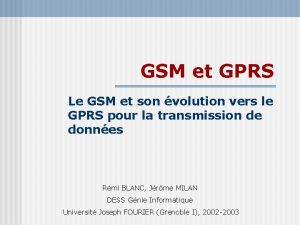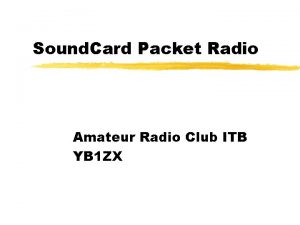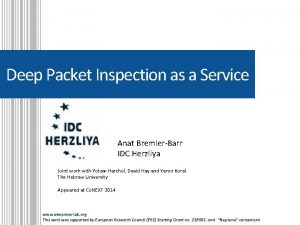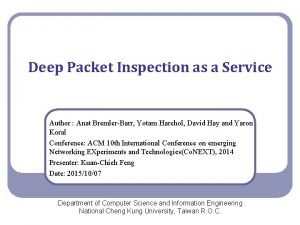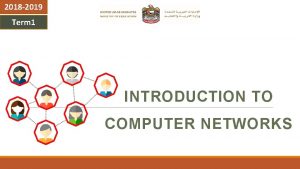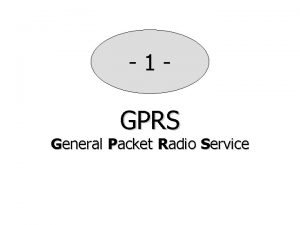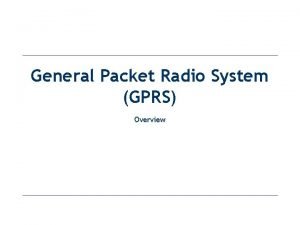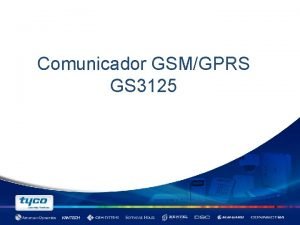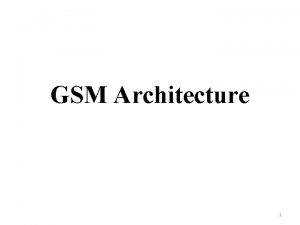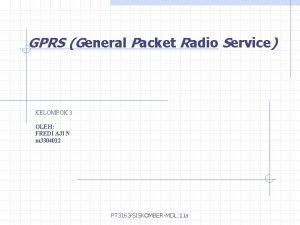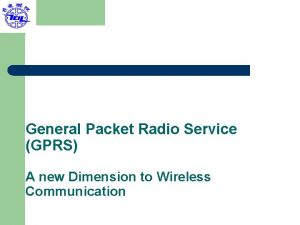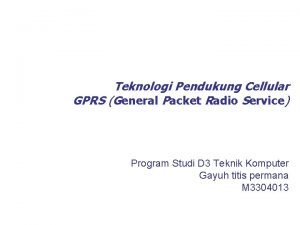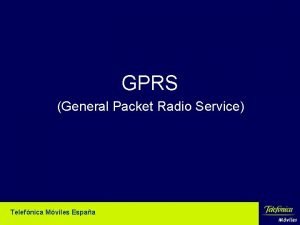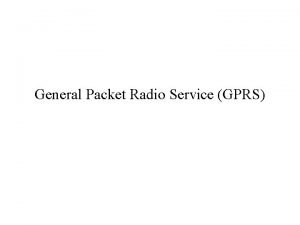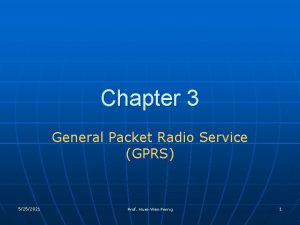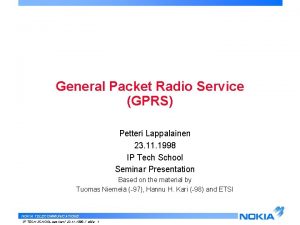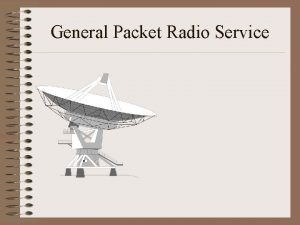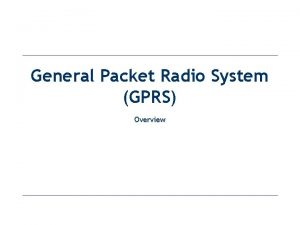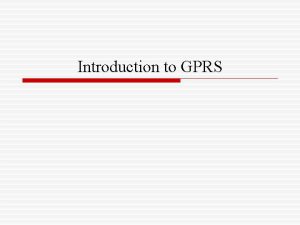GPRSGeneral Packet Radio Service Introduction GPRS Architecture GPRS
















- Slides: 16

GPRS-General Packet Radio Service • • Introduction GPRS Architecture GPRS Protocol Architecture GPRS QOS Classes Packet routing Access modes.

GPRS-General Packet Radio Service. Introduction • • It is a 2. 5 G technology. It is a packet oriented mobile data service. Data rate is (56 -114 Kbps) Uses TDMA mechanism

GPRS-General Packet Radio Service. Architecture

GPRS-General Packet Radio Service. Architecture GPRS consist of • Mobile station • Base station subsystem • GSN-GPRS Supporting node. These are routers. (i) SGSN-Serving GPRS Support Node. (ii) GGSN-Gateway GPRS Support Node. All GSN nodes are integrated into the standard GSM architecture.

GPRS-General Packet Radio Service. Architecture GPRS Support Nodes • Following two new components, called Gateway GPRS Support Nodes (GSNs) and, Serving GPRS Support Node (SGSN) are added: Gateway GPRS Support Node (GGSN) • The Gateway GPRS Support Node acts as an interface and a router to external networks. • It contains routing information for GPRS mobiles, which is used to tunnel packets through the IP based internal backbone to the correct Serving GPRS Support Node. • The GGSN also collects charging information connected to the use of the external data networks and can act as a packet filter for incoming traffic. Serving GPRS Support Node (SGSN) • The Serving GPRS Support Node is responsible for authentication of GPRS mobiles, registration of mobiles in the network, mobility management, and collecting information on charging for the use of the air interface

GPRS-General Packet Radio Service. Architecture SGSN and GGSN are Internal Backbone to GPRS • The internal backbone is an IP based network used to carry packets between different GSNs. • Tunneling is used between SGSNs and GGSNs, so the internal backbone does not need any information about domains outside the GPRS network. • Signaling from a GSN to a MSC, HLR or EIR is done using SS 7.

GPRS-General Packet Radio Service. Protocol Architecture The flow of GPRS protocol stack and end-to-end message from MS to the GGSN is displayed in the below diagram. GTP is the protocol used between the SGSN and GGSN using the Gn interface. This is a Layer 3 tunneling protocol.

GPRS-General Packet Radio Service. Architecture GTP: GPRS tunneling protocol • It is used to transfer data within GPRS backbone(Between SGSN and GGSN). • It uses 2 different protocols namely either: (i) Reliable TCP (ii) Unreliable UDP. SNDCP: Sub Network Dependent Convergence Protocol LLC : Logical Link Control Protocol SNDCP and LLC combination used in between the SGSN and the MS. • The SNDCP flattens data to reduce the load on the radio channel. • A safe logical link by encrypting packets is provided by LLC and the same LLC link is used as long as a mobile is under a single SGSN.

GPRS-General Packet Radio Service. QOS • Quality of Service (Qo. S) requirements of conventional mobile packet data applications are in assorted forms • The Qo. S is a vital feature of GPRS services as there are different Qo. S support requirements for assorted GPRS applications like real time multimedia, web browsing, and e-mail transfer. GPRS allows defining Qo. S profiles using the following parameters : • Service Precedence • Reliability • Delay and • Throughput

GPRS-General Packet Radio Service. QOS Service Precedence • The preference given to a service when compared to another service is known as Service precedence. This level of priority is classified into three levels called: Ø High Ø Normal or Medium Ø Low • When there is network congestion, the packets of low priority are discarded as compared to high or normal priority packets

GPRS-General Packet Radio Service. QOS Reliability • This parameter signifies the transmission characteristics required by an application. • The reliability classes are defined which guarantee certain maximum values for the probability of loss, duplication, missequencing, and corruption of packets. Delay • The delay is defined as the end-to-end transfer time between two communicating mobile stations or between a mobile station and the GI interface to an external packet data network. • This includes all delays within the GPRS network, Ø e. g. , The delay for request and assignment of radio resources Ø The transit delay in the GPRS backbone network. • Transfer delays outside the GPRS network, Ø e. g. , in external transit networks, are not taken into account

GPRS-General Packet Radio Service. QOS Throughput • The throughput specifies the maximum/peak bit rate and the mean bit rate. • Using these Qo. S classes, Qo. S profiles can be negotiated between the mobile user and the network for each session, depending on the Qo. S demand the available resources. • The billing of the service is then based on the transmitted data volume, the type of service, and the chosen Qo. S profile.

GPRS-General Packet Radio Service. Classes • The MS comprises of Terminal Equipment (TE) and Mobile Terminal (MT). • TE is the equipment that accommodates the applications and the user interaction, while the MT is the part that connects to the network.

GPRS-General Packet Radio Service. Classes There are three different classes of GPRS terminal equipments: Class A • Class A terminals can manage both packet data and voice simultaneously. • Which means, one needs two transceivers, as the handset has to send or receive data and voice at the same time. • This is the main reason why class A terminals are high-priced to manufacture than class B and C terminals. Class B • Class B terminals do not play the same role like Class A. • These terminals can manage either packet data or voice at a time. • One can use a single transceiver for both, resulting in the low cost of terminals. Class C • Class C terminals can manage either only packet data or only voice.

GPRS-General Packet Radio Service. Packet routing • Data routing or routing of data packets to and from a mobile user, is one of the pivot requisites in the GPRS network. The requirement can be divided into two areas: • Data packet routing • Mobility management.

GPRS-General Packet Radio Service. Access modes • The GPRS access modes specify whether or not the GGSN requests user authentication at the access point to a Public Data Network (PDN). The available options are: • Transparent - No security authorization/authentication is requested by the GGSN. • Non-transparent - In this case, GGSN acts as a proxy for authenticating.
 Gprs architecture
Gprs architecture Private apn architecture
Private apn architecture Architecture gprs
Architecture gprs Gprs architecture
Gprs architecture Baycom modem
Baycom modem Conventional radio system
Conventional radio system Deep packet inspection architecture
Deep packet inspection architecture Deep packet inspection architecture
Deep packet inspection architecture Introduction to cisco packet tracer
Introduction to cisco packet tracer Gprs cdma
Gprs cdma Gprs
Gprs Gprs overview
Gprs overview Gprs dsc 3125 manual español
Gprs dsc 3125 manual español Kepanjangan dari gprs adalah... *
Kepanjangan dari gprs adalah... * Gprs stands for
Gprs stands for Sgsn stands for
Sgsn stands for Hlr and vlr in gsm
Hlr and vlr in gsm


